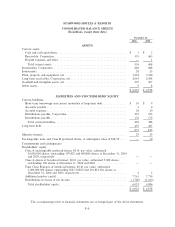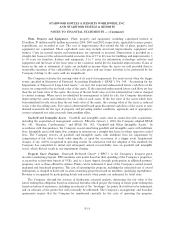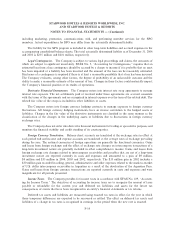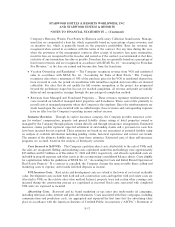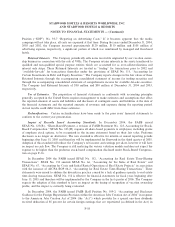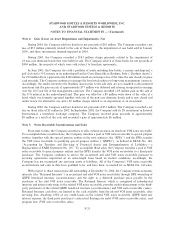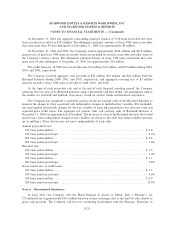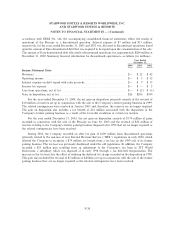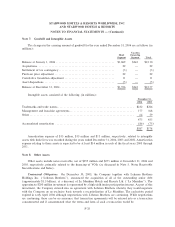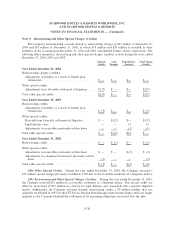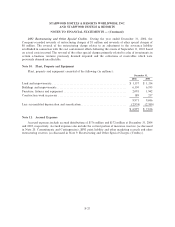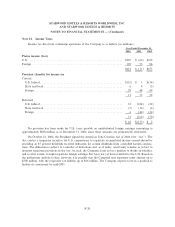Starwood 2004 Annual Report Download - page 84
Download and view the complete annual report
Please find page 84 of the 2004 Starwood annual report below. You can navigate through the pages in the report by either clicking on the pages listed below, or by using the keyword search tool below to find specific information within the annual report.STARWOOD HOTELS & RESORTS WORLDWIDE, INC.
AND STARWOOD HOTELS & RESORTS
NOTES TO FINANCIAL STATEMENTS Ì (Continued)
Position (""SOP'') No. 93-7 ""Reporting on Advertising Costs.'' If it becomes apparent that the media
campaign will not take place, all costs are expensed at that time. During the years ended December 31, 2004,
2003 and 2002, the Company incurred approximately $120 million, $110 million and $105 million of
advertising expense, respectively, a signiÑcant portion of which was reimbursed by managed and franchised
hotels.
Retained Interests. The Company periodically sells notes receivable originated by our vacation owner-
ship business in connection with the sale of VOIs. The Company retains interests in the assets transferred to
qualiÑed and non-qualiÑed special purpose entities which are accounted for as over-collateralizations and
interest only strips. These Retained Interests are treated as ""trading'' for transactions prior to 2002 and
""available-for-sale'' for transactions thereafter under the provisions of SFAS No. 115, ""Accounting for
Certain Investments in Debt and Equity Securities.'' The Company reports changes in the fair values of these
Retained Interests through the accompanying consolidated statement of income for trading securities and
through the accompanying consolidated statement of comprehensive income for available-for-sale securities.
The Company had Retained Interests of $58 million and $50 million at December 31, 2004 and 2003,
respectively.
Use of Estimates. The preparation of Ñnancial statements in conformity with accounting principles
generally accepted in the United States requires management to make estimates and assumptions that aÅect
the reported amounts of assets and liabilities and disclosure of contingent assets and liabilities at the date of
the Ñnancial statements and the reported amounts of revenues and expenses during the reporting period.
Actual results could diÅer from those estimates.
ReclassiÑcations. Certain reclassiÑcations have been made to the prior years' Ñnancial statements to
conform to the current year presentation.
Impact of Recently Issued Accounting Standards. In December 2004, the FASB issued
SFAS No. 123(R), ""Share-Based Payment, a revision of FASB Statement No. 123, Accounting for Stock-
Based Compensation.'' SFAS No. 123(R) requires all share-based payments to employees, including grants
of employee stock options, to be recognized in the income statement based on their fair value. Proforma
disclosure is no longer an alternative. The new standard is eÅective for interim or annual reporting periods
beginning after June 15, 2005 and therefore will be implemented for Starwood in the third quarter of 2005.
Adoption of this standard will reduce the Company's net income and earnings per share, however it will have
no impact on cash Öow. The Company is still analyzing the various valuation models and does not expect the
expense to be higher than the proforma stock-based compensation disclosed under Stock-Based Compensa-
tion on page F-16.
In December 2004 the FASB issued SFAS No. 152, ""Accounting for Real Estate Time-Sharing
Transactions''. SFAS No. 152 amends SFAS No. 66, ""Accounting for the Sales of Real Estate'' and
SFAS No. 67, ""Accounting for Costs and Initial Rental Operations of Real Estate Projects'' in association
with the issuance of AICPA SOP 04-2, ""Accounting for Real Estate Time-Sharing Transactions''. These
statements were issued to address the diversity in practice caused by a lack of guidance speciÑc to real estate
time-sharing transactions. SFAS No. 152 is eÅective for Ñnancial statements for Ñscal years beginning after
June 15, 2005 and therefore will be implemented by the Company in the Ñrst quarter of 2006. The Company
expects the adoption of this standard to have an impact on the timing of recognition of vacation ownership
proÑts, and the impact is currently being evaluated.
In December 2004, the FASB issued FASB StaÅ Position No. 109-2, ""Accounting and Disclosure
Guidance for the Foreign Repatriation Provision within the American Jobs Creation Act of 2004'' in response
to the American Jobs Creation Act of 2004 (the ""Act'') which provides for a special one-time dividends
received deduction of 85 percent for certain foreign earnings that are repatriated (as deÑned in the Act) in
F-18


